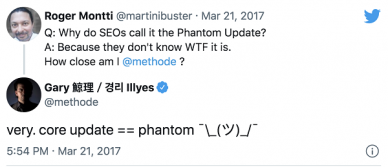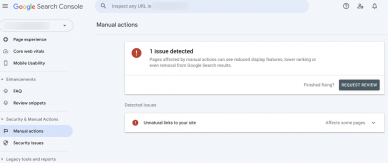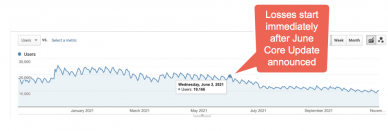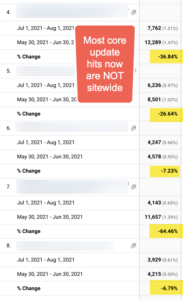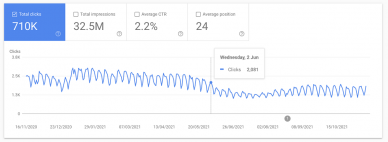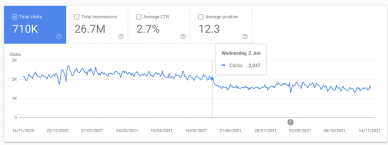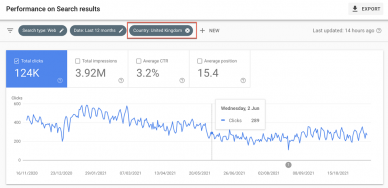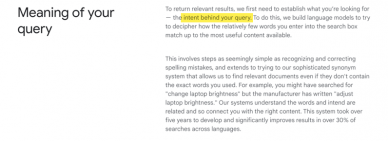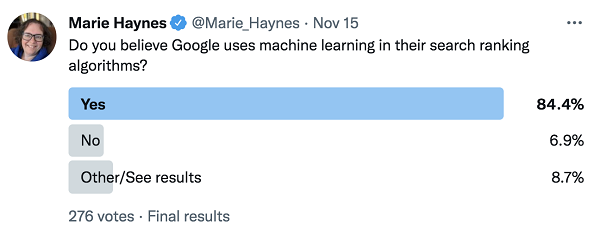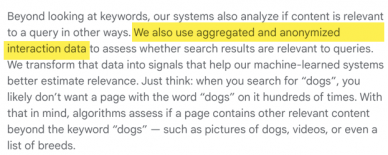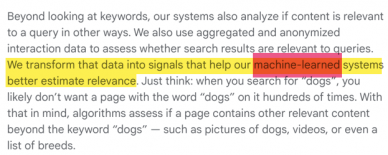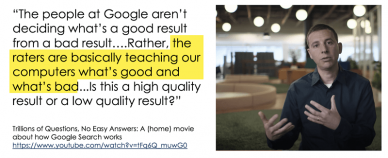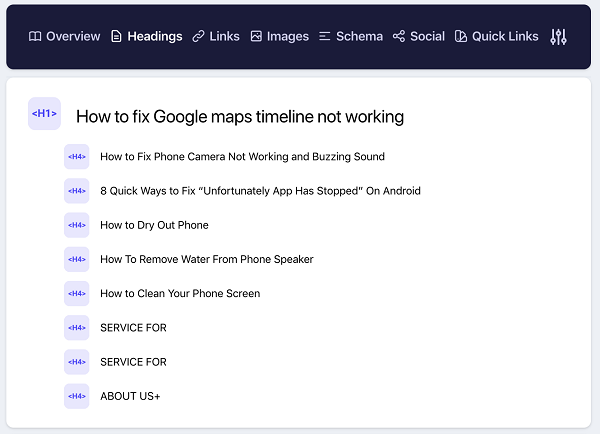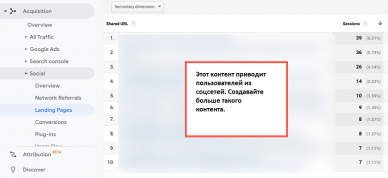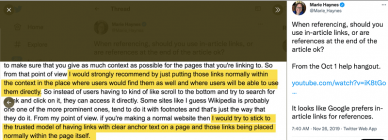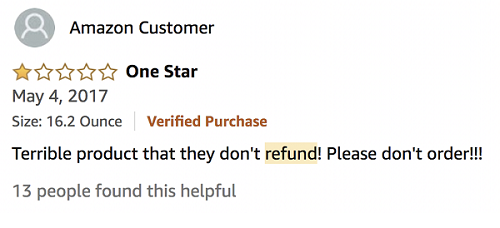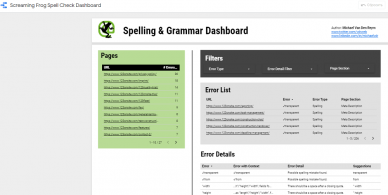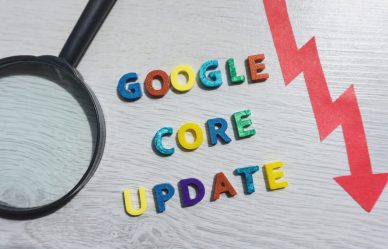
- Core Updates is one of the Google Updates
To improve search results, Google is constantly implementing changes that contribute to the gradual improvement of SERP, which the user may not even notice.
- The main algorithm updates several times annually
Such significant changes (critical updates) occur several times a year. Their goal is to help users find the right trustworthy content for them. At the same time, they can influence how materials are selected for Google recommendations.
- The purpose of crucial updates is to improve indicators such as relevance and reliability of search results
In other words, Google does not seek to punish resources that break established rules or sites with a bad reputation.
- Core Updates are launched after notification from Google
We continuously report such updates because they can affect numerous users and sometimes even increase or decrease the traffic of some sites. However, in many cases, they do not need to change anything. Our task is to help owners of resources with deteriorating performance eliminate the problems while avoiding mistakes.
- Some of the Core Updates were “phantom”
As SEO consultant Glenn Gabe said, “phantom” updates began to be called updates that defy explanation by webmasters.
- Decline in ranking position after Core Update is not always due to issues with your resource
In our opinion, any site after the Core Update has prospects for improvement. In practice, this task becomes much more complicated if there is a need to make the content of millions of pages of better quality and more valuable.
- Core Update is not a sanction
If you use manual actions for the resource, they are displayed in the Search Console:
In the case of manual sanctions, we are not talking about the fact that the main algorithm has been updated. A significant decrease in traffic in the absence of manual sanctions is a consequence of the functioning of the algorithmic filter and not sanctions.
- In case of an algorithmic reduction, there is no opportunity to re-apply for verification
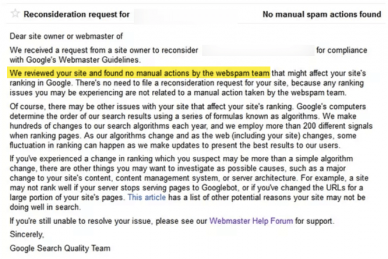
Google will respond with a message stating that no manual spam actions are found. If there are no manual sanctions, then the update of the algorithms influences the worsening of the positions.
If the performance of pages has decreased after a particular update, this does not mean that something is wrong with it. They do not violate our guidelines for web admins, and no action has been taken on them, either manually or automatically. Critical updates are not made for specific pages and sites, and they are designed to enable our systems to better rate content in general. Therefore, the page rank that was not high enough before could increase after the changes.
How to make sure that the traffic decrease is due to Core Update?
- Once an update is launched, changes can usually be seen within a day.
- According to Google, the position of several resources that passed through the June 2021 Core Update improved after the July 2021 Core Update

This situation is not a standard for all pages. There are many examples of site rankings improving or worsening during both updates (June and July).
- If there is a decrease in traffic from other search engines
The Core Update can be a reason for reducing traffic on rare occasions, so the simultaneous reduction in traffic from other search engines indicates other reasons.
Organic traffic from Google:
- Pay attention to recent changes to your resource
One of the main reasons for the drop in traffic may be recent changes, so they need to be considered. Admittedly, this is not easy to figure out.

In the figure above, you can see the situation when the traffic has decreased. The decline coincided with Google’s timeline update; however, this is unrelated. The site was launched when the Panda update was releasedbut was only connected to analytics in June. This is an example of our resource. We launched a redesign, forgetting about analytics: this also happens.
- The problem is rarely the only one
There is rarely just one recovering problem for a site after a Core Update that needs to be fixed.

Above, you can see a screenshot of a site whose rankings have been deteriorated since the Panda update. In 2014, we restored them after removing uninformative content, and a particular script was used and developed within a few minutes.
Our customers’ experience shows that only resources that regularly improve quality in a great number of areas can count on good results after a Google update.
- It is essential to identify which parts of the site are affected
The update may affect parts of the site, and it is vital to identify them. By analyzing Google’s algorithms, effective improvements can be made. Check out some troubleshooting tips below.
- Has the entire site gone down?
Use analytics data to compare current data with one month ago.


If the positions of all resource pages have been worsened, then it’s a problem for the entire site. However:
- Core Update changes often do not hit the sitewide
- Not only technical problems can lead to a decrease in traffic
There is a possibility that slumping in positions, reflected in most of the site’s pages, has technical roots. But in the case of Core Updates, such technical errors are rarely the cause.
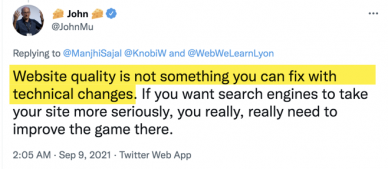
As John Mueller from Google said, not only technical changes are needed to boost resource quality.
- Review the indexing report data in Search Console
It would help if you focused on the number of URLs to be indexed. If there are crawled pages marked as not indexed, then in some cases, this may indicate that the pages do not meet the quality requirements of the search engine.
Some of our clients have seen significant improvements when these pages have been removed from the index. It allowed us to keep only the highest quality pages on the resource.
- Improving positions involves improving a large number of quality criteria
Here are a few tips on using the Search Console to reduce searching for places that need to be upgraded.
- How positions have changed depending on the device
If positions for mobile devices have decreased compared to desktops, you should evaluate how the experience of working with your resource on a mobile device differs from competitors’ resources.
Desktops:
- How indicators have changed depending on the region
It makes sense to check indicators after Core Updates for severe deviations. If there is a point of change in some countries or regions, you can understand which SERP and competitors you should analyze.
- Core updates may affect image search
Updates can affect any content, including images, because any content has some influence on rankings. So our page has a lot of information about “content”: https://t.co/nF7Ashb3Zk.
- There is no point in link rejection for recovering after Core Update
Links rejection is needed for sites where plenty of specially created links do not meet Google’s requirements. The presence of spam links plays no role in worsening positions compared to changes in Google’s assessment of the whole site’s relevance.
- The primary condition for restoration is the quality of the content
If one of the critical updates influences the traffic of some pages badly, this does not mean that the ones must be fixed. However, the desire of the owners of such sites to change the situation is quite understandable. We recommend focusing on the quality of the content you publish because this criterion is the basis of our algorithms. What does it mean? Typically, SEO specialists pay attention to factors that can be “measured”.
- Here are clear Google recommendations about how to gain the quality level of the site
They can be found in the post «What do you need to know about Google Core Update».
- The list of recommendations similar to the Google Assessor Guide
We offer you to study the full version of the Google Assessor Guide, where you will find a lot of useful information. The document was last updated in October.
- Core Updates help you understand what the user is waiting for and what information they are looking for
Google seeks to determine what the user wants by placing their request.
Source: How Google Search works
- Updates define relevance requirements
Source: Understanding searches better than ever before
In this case, we are talking about Machine Learning, being not yet very popular in the SEO environment.
- Google makes no secret of its use of interaction data
It is done to evaluate the relevance of the search results. It is impossible to say where this data comes from real users or search assessors.
Source: Understanding searches better than ever before
- The received data is transformed into signals that help ML-systems to conduct a better relevant assessment
Source: Understanding searches better than ever before
- Google can use Machine Learning to evaluate various “intangible” factors that involve rankings
Above, you can see a phrase from a film created by Google about how the search engine works «Trillions of Questions, No Easy Answers»:
“… The raters are basically teaching our computers what is good and what is bad …”. It is a good film with a lot of exciting things, and we recommend watching it. Recently, machine learning has been widely used by Google.
- If Google uses machine learning in its work to determine ranking positions, then soon, the known “ranking factors” may sink into oblivion
Google’s employee John Mueller claims that the company is moving away from using “200+ ranking factors” because it’s not true.
- If the source of the link is an authoritative resource, then it is included in E-A-T and increases the credibility of the site from the search engine
Source: Understanding searches better than ever before
It is because…
- Links define authority
Source: How Google Fights Disinformation
There is a strong relationship between PageRank and authority. Is it necessary to focus on link building in this regard?
- Better Focus on Creating Mentions
Google’s algorithms can distinguish trusted links from those created for marketing purposes or solve SEO problems.
- Improving E-A-T is possible by getting mentions or links from authoritative sources
It is not so easy at first glance. If the optimizer receives a link often, then in most cases, Google will not consider it authoritative.
- If there is a mention, for example, on Search Engine Land, then Google perceives this information as more reliable in terms of SEO. If this happens often, we can talk about essential solid associations between us and the SEO topic.
If there is a mention, for example, on Search Engine Land, then Google perceives this information as more reliable in terms of SEO. If this happens often, we can talk about essential solid associations between us and the SEO topic.
- It is difficult to achieve content improvement for sites with a large number of pages
Many of the features offered are purely page-based, so they won’t work for sites with thousands or millions of pages.
- Some features can be scaled and applied
It is possible to make changes to the layout or design of the site to improve its utility to users—for example, the addition of a block in which the author’s data is indicated.
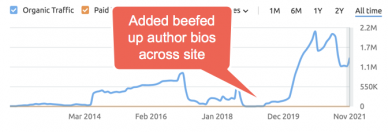
Check out the Google Blog for a list of top questions to improve your articles. Analyze the content whose positions have been diminished after the Core Update with those whose positions have been raised.
- Articles exclusivity: Do you emphasize facts, reporting, analysis, or research?
How valuable are your articles to users compared to other articles on the same topic on the internet? Will users opt for your content, especially if your competitors are reputable? The easiest way to find out is through surveys.
- Determine what your users are interested in and give it to them
Do you want to know what users prefer? Find out from them.
- What may help you to find questions for users?
Using social media will help to find the most critical questions for users.
- You should disclose all topics as much as possible
Develop and expand each topic thoroughly.
- Focus on quality to rank content; quantity will let you down
Rate similar content that ranks better than yours. Why does it attract users? Perhaps it contains a more straightforward answer to the user’s request.
- Focus on user needs for creating content
Source: Google Assessor Guide
It is a significant thing. Assessors of Google know that if a page satisfies users’ needs, they will not look elsewhere because they will get all the necessary information on this page. Such a page will meet the intent of almost all users.
- Pay attention to details, not just facts
Usually, the content is reduced to a clear answer to a specific question. It is important to detail this information as much as possible to compare it favorably with other similar sites on the network. Therefore, do not only focus on bare facts: make articles more valuable to users.
- How do you deliver the news?
- Are original materials posted on the site (facts, reports, research, analytics)?
- Do you cover the topics fully and thoroughly?
- Does your site contain deep analytics or interesting and non-obvious facts?
- Has the content been taken from other sources been processed sufficiently to be of significant value in this form?
Find a way to make the information you share more “exclusive” and attractive so that users are interested in it. You may be satisfied with the “bare facts” only if you have achieved the status of an authoritative source.
- Examine the headlines of your competitors
- How informative is the headline and title of the page, and does it reflect the content?
- Is there anything shocking or exaggerated in the headline and title of the page?
You should pay particular attention to headings because Google styles your content according to the ones. In addition, headings make it easier for users to find the information they need.
- Why do users only stop at headlines? Perhaps the information is not valuable for them
You can use Chrome’s Detailed extension to find out users’ interests who view only headlines.
Based on the rating, you will receive recommendations.
Nevertheless, there is no need to add bulleted lists to every page, and it is essential to take a closer look at the higher-ranking pages. Do they have such lists, and do they help users find the information they need more quickly.
Other points are equally important…
- How users read on the web
Site visitors no longer tend to read web pages word by word; they prefer to scan the page, highlighting individual words and sentences.
- Bold text improves its SEO performance
Highlighting parts of the text in bold increases the efficiency of its “scanning” by users. Google’s John Mueller emphasized that such highlighted text affects positioning.
- Don’t Use Clickbait Headlines
The headline should not contain anything shocking or exaggerated.
Miley Cyrus is NOT dead (this example is provided in the Google Assessor Guide):
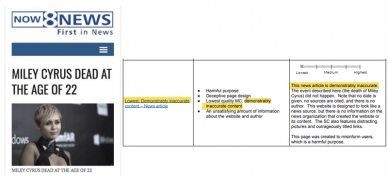
Confusing headlines are viewed negatively by users and Google.
- Does the content on your site make you want to share it?
- Are you ready to share such a page with your friends, bookmark it or recommend it to other users?
- Could such material be published or mentioned in a printed journal, encyclopedia, or book?
- Estimate how many users are switching from social media
Explore content that many users have reposted. Strive to increase your level to match. In this case, there will be a lot of reposts, and the ranking positions will increase. To achieve this, you must know what is helpful to users.
- Don’t Forget About Source Links
Can the information integrity not be doubted in the way you present it? Cited sources, evidence of the author’s competence, and biographical information about him or information about the site where he is published (in particular, links to the author’s page or the “About Us” page of such a site) may speak in your favor.
Links will increase reader confidence in your content.
- Use only trusted sources
Which article will be most trusted by users: the one that links to someone’s blog or has links to trusted sources and scientific papers?
- Quotes should be woven into the body of the article rather than inserted at the end
Quotes inserted into an article are better accepted by Google:
- Add Author Details
It links to the author’s page or information about him indicated in the article. It will help readers evaluate the qualifications of your authors and learn more about them.
- The “About us” page
The “About Us” page should contain primary data about the company and its employees. Links to the author’s page or the “About Us” page of such a site may speak in your favor.
- Work for your reputation
Analyzing the available information about the site, can we conclude that it is highly trusted or widely recognized as a source of data on the topic it covers?
If a site fails to meet user expectations regularly, Google will not recommend it.
- Respond to customer feedback
It is unpredictable how positive or negative reviews modify ranking positions. However, your reaction indicates a desire to meet customers and solve their problems.
Source: Google Patent
- Try to get satisfied customers to leave positive feedback
Positive feedback helps motivation, boosts confidence, and shows your value for people.
- PR is vital
Based on the available information about the site, can we conclude that it is highly trusted or widely accepted as anorigin of data on the topic covered?
To get the status of an authoritative source, you should focus on public relations. We are talking about all sorts of references and links in sources trusted by users, and it works for the benefit of brand recognition, the site, and its authors.
- Explore Getting a Page on Wikipedia
Source: Google Assessor Guide
The presence of such a page will not automatically increase ranking positions. If you are famous already, it makes sense to consider such a possibility.
- Avoid grammar and spelling mistakes
Сheck content for stylistic and spelling errors.
- You can scan a large block of content for errors using Screaming Frog
Source: Google Data Studio
- Remember: quality is essential, not quantity
Is the content well-crafted, or does it appear to have been prepared in a hurry?
Was there enough attention paid to each page on the site, or did different authors write them with no overall direction, and the content was scattered across various resources?
Now the quality of content has come to the fore, although a few years ago, large volumes of medium quality content ranked well. Today, one should choose to favor high-quality content, and its quantity is secondary.
- Does advertisement on the page cause negative emotions in users?
Are there countless ads on the page that distract from the main content or interfere with browsing?It is impossible to measure how much advertising is sufficient in user perception. If it is annoying, then the site’s ranking indicators may decrease.
- How the content is displayed on mobile devices
Are there any troubles with revealing information on mobile devices?
Compare your site render on mobile devices and how it looks compared to competitors’ sites. You can do UX tests to advance user experience and increase user satisfaction.
- Post quality texts that captivate users
This series of tweets from Rich Tatum will help you master the rules of writing them.
Next, we will talk about how to restore after Core Updates. What may you expect if the above requirements are met?
- Core Updates is not the end of your resource; there is still a possibility of recovery
- There is room to bounce back before the next one or two Core Updates
After Core Update, authors and site owners often have a question: if we improve the content, how long will it take for the site to return to its previous performance?
Core Updates are released every few months. Even if you take the necessary measures, pages that are negatively affected by one update may not have time to return to their indicators until the next.
- Good results are achieved by sites that constantly work on the quality of content
Traffic will gradually recover as Google determines that your content is more relevant and valuable than competitors. At first, you will observe its growth steadily, and then the traffic will stabilize.
- Subscribe to valuable links
You will be first in line to get exclusive content. Also, it gives you the advantage to be the first to react.

